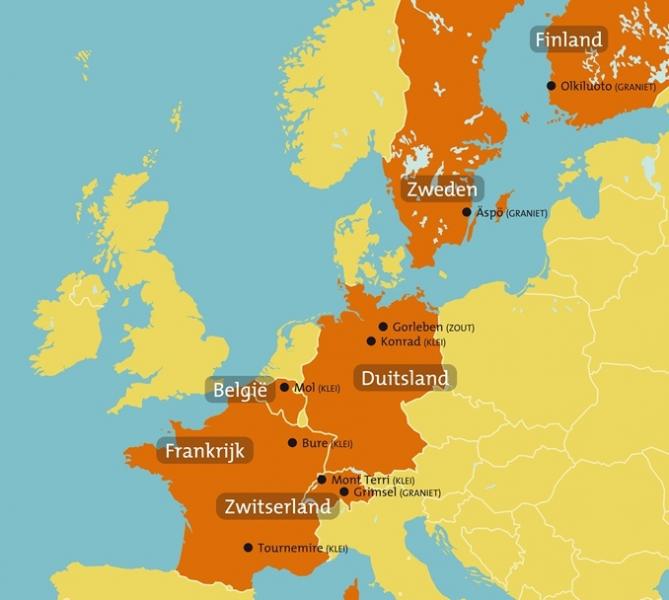HADES in a European context
Underground research laboratories in Europe
Underground research laboratories make it possible to acquire the expertise necessary to develop a safe waste repository. They are located in geological strata that are considered suitable for geological disposal, or in an underground substrate that is sufficiently representative to conduct appropriate research. A number of European underground laboratories that are researching geological disposal are shown on the map below.

Map showing underground research laboratories in neighbouring countries
The type of rock in which the laboratory is built is indicated in brackets.
In some cases, the laboratories have been built as an extension to an existing mine or tunnel, such as the two in Switzerland, for example: Mont Terri (in hard clay) and Grimsel (in granite). In other cases, the laboratories are stand-alone underground facilities, designed purely for geological disposal research. The Bure laboratory in eastern France is one such example, and is located at a depth of more than 400 m in a hard clay formation. Onkalo in Finland is another example of an underground facility that was built solely for the purpose of researching geological disposal in a granite bedrock. In this particular case, the laboratory is also the first step on the way towards a real waste repository. These are just a few examples that illustrate the variety of the existing underground research laboratories.
Research projects on the behaviour of clay bring together experts from other underground laboratories and research institutions investigating clay as a potential host rock for a geological repository. This collaboration leads to knowledge-sharing and encourages critical evaluation of research and development programmes. It also helps support the development of a common European and international approach to the key issues of geological disposal of radioactive waste. At European level, the projects conducted are co-funded by the European Commission.
HADES
Renowned worldwide, HADES is the oldest underground laboratory in Europe built in a deep clay formation for the purpose of researching the possibility of geological disposal in clay. The International Atomic Energy Agency (IAEA) recognises it as a centre of excellence for waste disposal technologies and scientific training. HADES is a licensed nuclear research facility, which means that scientists can use a wide range of radioactive tracers and sources. Given that the first section became operational in the early 1980s, there are experiments under way that have been closely monitored for more than 25 years. EIG EURIDICE opens up HADES to other research groups, both Belgian and international, for experimental purposes.
HADES is and will always remain a research facility. It will never be used as a final repository for radioactive waste.
